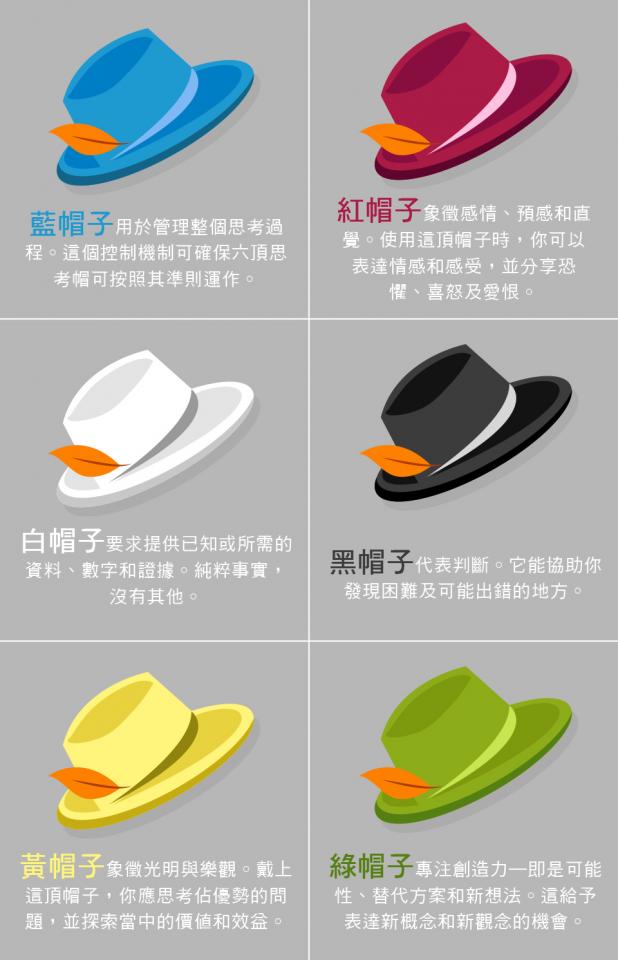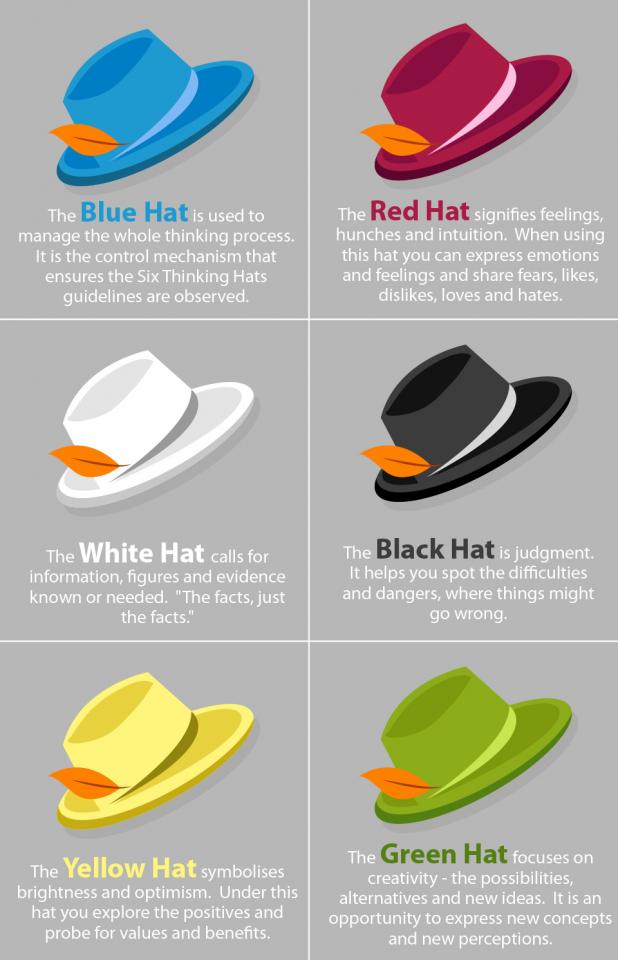你帶的帽子是什麼顏色?
六頂思考帽是由心理學家Edward de Bono博士在1980年代發展的思維過程。它提出在思考過程中,人們可以利用代表不同思維方式的假想「帽子」作為思考工具。當面對問題、處境和理念時,這種平行思維技巧使我們能夠從不同角度,以不同重點進行思考。六頂思考帽方法可於學生和教師探索複雜問題或場景時,為他們提供六個不同觀點,協助分析。本文將介紹每頂帽子的功能以及如何利用它們在課室中培養學生的思考能力。
每頂帽子所代表的思維方式
先讓我們來看看不同帽子所扮演的角色和功能。

(圖像由教學中心提供,2020)
使用六頂思考帽於日常教學
由於六頂思考帽具有六個不同的思維重點,因此教師可以整合六頂思考帽方法,以促進學與教活動。教師不妨考慮利用以下的一些引導性問題來促進討論、小組活動和匯報。
1. 藍帽子,又稱為「管理帽」, 可以在展開傾談時使用。它可以協助學生確立項目的大綱,或作最後總結和結論。引導性問題可以是:目的是什麼?2. 教師可以鼓勵學生戴上白帽子來尋找事實和數據。我們可以問:這是什麼概念?它對什麼人起作用?
3.在沮喪的時候,黃帽子可以使學生重拾他們對學習的積極性和肯定。學生可以問自己:這個理念有多好?它可以帶來多大的效益?
4. 接下來是紅帽子。這頂帽子可以讓學生尋找與意念相關的情感。他們可以問:這讓我感覺如何?其他人會對這個意念有何感想?
5. 然後,學生不妨以比較負面的角度去看該意念,即是黑帽子的功能。學生大可跟自己對質:這想法為什麼行不通?問題出現在哪裡?
6. 通過預計可能出現的問題,學生可以更全面檢視該情況,並尋求解決方案。因此,學生可以戴上綠帽子尋求針對漏洞和解決問題的方案。引導問題包括:如何改進?會有更好的主意嗎?
(取自Stephen Moore (由教學中心翻譯),2019)
結論
了解這六種不同的思維方式及其重點後,學生就能夠更輕鬆地了解其他人對某意念的看法和原因了。這有助於他們反思他們最初的想法,並從另一個角度重新思考它,及考慮其他人的觀點。
參考文獻:
Stephen, M. (2019). Turn a Good Idea Into a Great One With the ‘Six Thinking Hats'. Retrieved June 4, 2020, from
https://forge.medium.com/turn-a-good-idea-into-a-great-one-with-the-six-thinking-hats-4d94a0d0e4d1
The de Bono Group. Retrieved June 4, 2020, from http://www.debonogroup.com/six_thinking_hats.php
What Color is Your Hat?
The Six Thinking Hats is a thinking process developed in 1980s by the psychologist Dr Edward de Bono. It suggests that people could wear different imaginary “hats”, which represent different mindsets and emotions, as a thinking tool. This parallel thinking technique empowers people to think from various angles with a different focus when we encounter a question, a situation and an idea. The Six Thinking Hats methodology helps students and teachers to explore six distinct perspectives of a complex issue or scenario. This article presents the functions of each hat and how they can be applied in the classroom to develop thinking skills.
What do the Hats Represent?
Let's begin with the roles and functions of each hat.

(Image courtesy of CLT, 2020)
Using the Six Thinking Hats in Your Classroom
Since the six thinking hats carry six different focuses of thinking, teachers can integrate the Six Thinking Hats methodology in facilitating the learning and teaching activities. The following are some guiding questions that teachers can consider when facilitating discussions, group work and presentations.
1. The Blue Hat, known as the Management Hat, can be used at the start of the conversation to define the outlines of a student project, and at the end to summarise and draw conclusions. The guiding question can be: What is its purpose?
2. Teachers can encourage students to wear the White Hat to look for facts and data. Questions to be asked: What is the concept? Who does it serve?
3. The Yellow Hat could come to students with positivity and reassurance to their work in times of frustration. Students can ask themselves: How great the idea is and how beneficial it can be.
4. Next is the Red Hat. This hat allows students to look for the emotion related to the idea. They can ask: How does this make me feel? How may others feel with the idea?
5. Then we twist the thinking process to the negative side of the idea, which is the function of the Black Hat. Students can confront themselves: Why wouldn't the idea work? Where are the issues and problems?
6. By revealing the possible problems, students can see a bigger picture of the situation and probably look for the solutions. In this connection, students can put on the Green Hat to seek solutions for the flaws and issues. Questions may include: How can it be improved? Would there be a better idea?
(Adopted from Stephen Moore, 2019)
Conclusion
By understanding the six different thinking styles and their focuses, students would be able to see what other people think about the idea and why more easily. It facilitates their reflection on what they originally think and rethink it in another perspective and consider others' perspectives.
References:
Stephen, M. (2019). Turn a Good Idea Into a Great One With the ‘Six Thinking Hats'. Retrieved June 4, 2020, from
https://forge.medium.com/turn-a-good-idea-into-a-great-one-with-the-six-thinking-hats-4d94a0d0e4d1
The de Bono Group. Retrieved June 4, 2020, from http://www.debonogroup.com/six_thinking_hats.php
